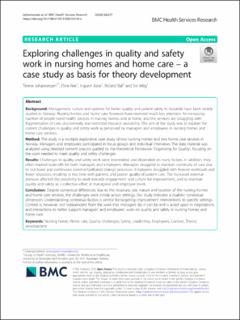| dc.contributor.author | Johannessen, Terese | |
| dc.contributor.author | Ree, Eline | |
| dc.contributor.author | Aase, Ingunn | |
| dc.contributor.author | Bal, Roland | |
| dc.contributor.author | Wiig, Siri | |
| dc.date.accessioned | 2020-08-18T13:06:41Z | |
| dc.date.available | 2020-08-18T13:06:41Z | |
| dc.date.created | 2020-04-06T18:59:04Z | |
| dc.date.issued | 2020-04 | |
| dc.identifier.citation | Johannessen, T., Ree, E., Aase, I. et al. (2020) Exploring challenges in quality and safety work in nursing homes and home care – a case study as basis for theory development. BMC Health Services Research, 20 | en_US |
| dc.identifier.issn | 1472-6963 | |
| dc.identifier.uri | https://hdl.handle.net/11250/2672850 | |
| dc.description.abstract | Background
Management, culture and systems for better quality and patient safety in hospitals have been widely studied in Norway. Nursing homes and home care, however have received much less attention. An increasing number of people need health services in nursing homes and at home, and the services are struggling with fragmentation of care, discontinuity and restricted resource availability. The aim of the study was to explore the current challenges in quality and safety work as perceived by managers and employees in nursing homes and home care services.
Method
The study is a multiple explorative case study of two nursing homes and two home care services in Norway. Managers and employees participated in focus groups and individual interviews. The data material was analyzed using directed content analysis guided by the theoretical framework ‘Organizing for Quality’, focusing on the work needed to meet quality and safety challenges.
Results
Challenges in quality and safety work were interrelated and depended on many factors. In addition, they often implied trade-offs for both managers and employees. Managers struggled to maintain continuity of care due to sick leave and continuous external-facilitated change processes. Employees struggled with heavier workloads and fewer resources, resulting in less time with patients and poorer quality of patient care. The increased external pressure affected the possibility to work towards engagement and culture for improvement, and to maintain quality and safety as a collective effort at managerial and employee levels.
Conclusion
Despite contextual differences due to the structure, size, nature and location of the nursing homes and home care services, the challenges were similar across settings. Our study indicates a dualistic contextual dimension. Understanding contextual factors is central for targeting improvement interventions to specific settings. Context is, however, not independent from the work that managers do; it can be and is acted upon in negotiations and interactions to better support managers’ and employees’ work on quality and safety in nursing homes and home care. | en_US |
| dc.language.iso | eng | en_US |
| dc.publisher | BioMed Central | en_US |
| dc.rights | Navngivelse 4.0 Internasjonal | * |
| dc.rights.uri | http://creativecommons.org/licenses/by/4.0/deed.no | * |
| dc.subject | pasientsikkerhet | en_US |
| dc.subject | sykehjem | en_US |
| dc.subject | hjemmesykepleie | en_US |
| dc.title | Exploring challenges in quality and safety work in nursing homes and home care – a case study as basis for theory development | en_US |
| dc.type | Peer reviewed | en_US |
| dc.type | Journal article | en_US |
| dc.description.version | publishedVersion | en_US |
| dc.rights.holder | © The Author(s). 2020 | en_US |
| dc.subject.nsi | VDP::Medisinske Fag: 700::Helsefag: 800 | en_US |
| dc.source.volume | 20 | en_US |
| dc.source.journal | BMC Health Services Research | en_US |
| dc.identifier.doi | 10.1186/s12913-020-05149-x | |
| dc.identifier.cristin | 1805478 | |
| dc.relation.project | Universitetet i Stavanger: 5091 | en_US |
| dc.relation.project | Norges forskningsråd: 256681 | en_US |
| cristin.ispublished | true | |
| cristin.fulltext | original | |
| cristin.qualitycode | 2 | |

